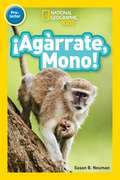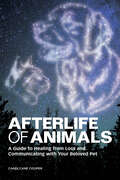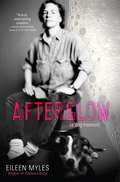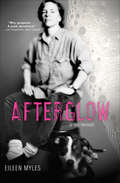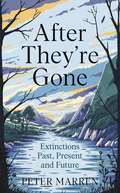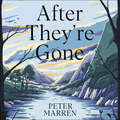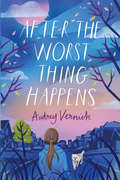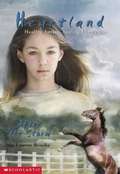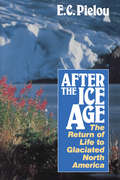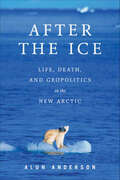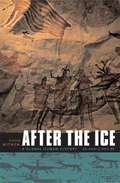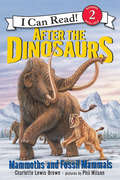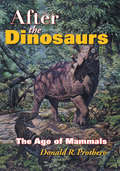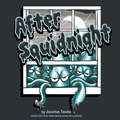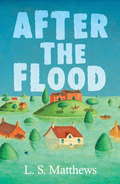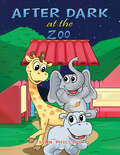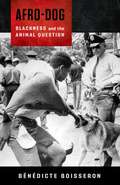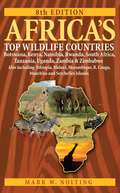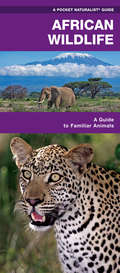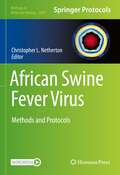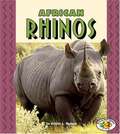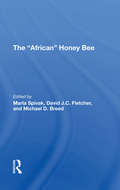- Table View
- List View
¡Agárrate Mono! 9781426332333 (Readers Series)
by Susan Neuman¡AHORA EN ESPAÑOL! Sigue la historia de un monito que aprende sobre la vida en la jungla. Obsérvalo colgándose de las ramas, columpiándose de árbol en árbol y andando sobre la espalda de su mamá. Este libro para principiantes utiliza vocabulario simple e imágenes divertidas para captar el interés y desarrollar las habilidades de lectores que recién empiezan a leer. Las locas travesuras, el humor y la información divertida hacen que esta lectura sea un placer. Los libros de National Geographic han tenido mucho éxito en la categoría competitiva de libros para principiantes, y este libro contribuye a este éxito con el mismo texto cuidadosamente nivelado e imágenes maravillosas. Ahora la serie se expande más allá de los niveles de la escuela primaria para llegar a los principios de la relación entre el niño y la lectura. Los libros Pre-Lectores de National Geographic utilizan la representación visual, la repetición y el reconocimiento para enseñar a los niños la base de esta hermosa habilidad.
Afterlife of Animals: A Guide to Healing from Loss and Communicating with Your Beloved Pet
by Candi Cane CooperConnect with and honor your animal companion with this gentle guide to the other side Losing a pet can be one of the hardest things you'll deal with. Although your companion may be physically gone, their presence is still with you every day. This exploration of pets and the afterlife is your resource for compassionate grieving and building a connection to your beloved pet even after they've crossed the Rainbow Bridge. Find tools to help you process the complex emotions of your loss and understand that however you're feeling is normal. Learn to read and interpret the different ways that your pet might be communicating with you from beyond, and find advice on how you can reach out to and honor their spirit and presence every day. Get help grieving the loss of a pet with guidance that includes: Animals of every shape and size—No matter what kind of companion you're missing, there's advice, healing, and guidance for you. Afterlife remembrance—Learn tactics that can help you value and cherish your sweet animal with little daily rituals. Rainbow Bridge FAQs—Find answers to all sorts of questions about what happens to our pets once they move on. Find comfort from your wonderful pet even after they've passed on.
Afterglow: A Dog Memoir
by Eileen Myles<P>This newest book paints a kaleidoscopic portrait of a beloved confidant: the pit bull called Rosie. <P>In 1990, Myles chose Rosie from a litter on the street, and their connection instantly became central to the writer’s life and work. During the course of their sixteen years together, Myles was madly devoted to the dog’s wellbeing, especially in her final days. Starting from the emptiness following Rosie’s death, Afterglow (a dog memoir) launches a heartfelt and fabulist investigation into the true nature of the bond between pet and pet-owner. Through this lens, we witness Myles’s experiences with intimacy and spirituality, celebrity and politics, alcoholism and recovery, fathers and family history, as well as the fantastical myths we spin to get to the heart of grief. <P>Moving from an imaginary talk show where Rosie is interviewed by Myles’s childhood puppet to a critical reenactment of the night Rosie mated with another pit bull, from lyrical transcriptions of their walks to Rosie’s enlightened narration from the afterlife, Afterglow (a dog memoir) illuminates all that it can mean when we dedicate our existence to a dog.
Afterglow: (a dog memoir) (Books That Changed the World)
by Eileen Myles“A ravishingly strange and gorgeous book about a dog that’s really about life and everything there is…astonishing.” ?Helen Macdonald, New York Times-bestselling author of H Is for HawkIn 1990, poet Eileen Myles chose Rosie from a litter of pit bulls on the street, and their connection instantly became central to the writer's life and work. During the course of their sixteen years together, Myles was madly devoted to the dog’s well-being, especially in her final days. Starting from the emptiness following Rosie's death, Afterglow launches a heartfelt and fabulist investigation into the true nature of the bond between pet and pet owner. Through this lens, we witness Myles’s experiences with intimacy and spirituality, celebrity and politics, alcoholism and recovery, fathers and family history, as well as the fantastical myths we spin to get to the heart of grief.Moving from an imaginary talk show where Rosie is interviewed by Myles’s childhood puppet to a critical reenactment of the night Rosie mated with another pit bull, from lyrical transcriptions of their walks to Rosie’s enlightened narration from the afterlife, Afterglow illuminates all that it can mean when we dedicate our existence to a dog.“Myles gets at something no other dog book I’ve read has gotten at quite this distinctly: The sense of wordless connection and spiritual expansion you feel when you love and are loved by a creature who’s not human…raw and affecting.” ?Maureen Corrigan, Fresh Air, NPR
After They're Gone: Extinctions Past, Present and Future
by Peter Marren'Wise, challenging and offering some unexpected laughter in the dark, this is a rational and insightful account of the sixth great extinction event. Peter Marren is a brilliant writer and a national treasure.' PATRICK BARKHAM'Thoughtful, fascinating and very timely.' STEPHEN MOSS'Important and thought-provoking.' CAROLINE LUCAS, GREEN PARTY MP'Essential reading. Marren makes a page-turner out of Armageddon.' SIMON BARNES'In his characteristic style Peter Marren has humanised the story of wildlife losses with humour and wit but also with his enormous knowledge and deep love for the living world.' MARK COCKERWe are in the midst of an extinction event: the sixth mass extinction on earth and one entirely caused by mankind. All species become extinct sooner or later, but we have accelerated that natural process several hundredfold and now, it is happening right in front of our eyes. Extinction has a terrifying finality to it. And many species have already been lost to us forever; there is little we can do about that.What we can do, however, is reflect, remember, and ultimately acknowledge the unvarnished truth. We must see the natural world as it is, and not as we might want it to be. Our trajectory is one that has benefited one species alone - humankind. For all other beings, from mammals to fish, from birds to insects and coral, from plants to lichens and fungi, the future, for better or worse, is in our hands.
After They're Gone: Extinctions Past, Present and Future
by Peter Marren'Wise, challenging and offering some unexpected laughter in the dark, this is a rational and insightful account of the sixth great extinction event. Peter Marren is a brilliant writer and a national treasure.' PATRICK BARKHAM'Thoughtful, fascinating and very timely.' STEPHEN MOSS'Important and thought-provoking.' CAROLINE LUCAS, GREEN PARTY MP'Essential reading. Marren makes a page-turner out of Armageddon.' SIMON BARNES'In his characteristic style Peter Marren has humanised the story of wildlife losses with humour and wit but also with his enormous knowledge and deep love for the living world.' MARK COCKERWe are in the midst of an extinction event: the sixth mass extinction on earth and one entirely caused by mankind. All species become extinct sooner or later, but we have accelerated that natural process several hundredfold and now, it is happening right in front of our eyes. Extinction has a terrifying finality to it. And many species have already been lost to us forever; there is little we can do about that.What we can do, however, is reflect, remember, and ultimately acknowledge the unvarnished truth. We must see the natural world as it is, and not as we might want it to be. Our trajectory is one that has benefited one species alone - humankind. For all other beings, from mammals to fish, from birds to insects and coral, from plants to lichens and fungi, the future, for better or worse, is in our hands.
After They're Gone: Extinctions Past, Present and Future
by Peter MarrenThe past, present and future of extinction from a world-leading naturalist.We are in the midst of an extinction event: the sixth mass extinction on earth and one entirely caused by mankind. All species become extinct sooner or later, but we have accelerated that natural process several hundredfold and now, it is happening right in front of our eyes. Extinction has a terrifying finality to it. And many species have already been lost to us forever; there is little we can do about that.What we can do, however, is reflect, remember, and ultimately acknowledge the unvarnished truth. We must see the natural world as it is, and not as we might want it to be. Our trajectory is one that has benefited one species alone - humankind. For all other beings, from mammals to fish, from birds to insects and coral, from plants to lichens and fungi, the future, for better or worse, is in our hands.'Wise, challenging and offering some unexpected laughter in the dark, this is a rational and insightful account of the sixth great extinction event. Peter Marren is a brilliant writer and a national treasure.' PATRICK BARKHAM'Thoughtful, fascinating and very timely.' STEPHEN MOSS'Important and thought-provoking.' CAROLINE LUCAS, GREEN PARTY MP'Essential reading. Marren makes a page-turner out of Armageddon.' SIMON BARNES'In his characteristic style Peter Marren has humanised the story of wildlife losses with humour and wit but also with his enormous knowledge and deep love for the living world.' MARK COCKER(P) 2022 Hodder & Stoughton Limited
After the Worst Thing Happens
by Audrey VernickLeft reeling after her thoughtless mistake causes a terrible accident, 12-year-old Army Morand channels her grief to help someone in need.Army Morand feels like her life has been blown to bits when the worst thing imaginable happens--her beloved dog dies. It was an accident, but it was also Army's fault. She can't seem to stop hiding from everything and everybody including her best friend JennaLouise. But then Army sees Madison, the little girl who moved in across the way, climbing a tree and walking down the street unsupervised. Her family is not neglectful, just overwhelmed. Army finds herself overcome with the need to help Madison's family to make sure another worst thing doesn't happen--which becomes even more challenging when a big storm threatens her town.After the Worst Thing Happens is a bittersweet story about a girl surprised by the force of a growing need inside her to reach out and lend a hand while trying to escape the swirling sadness of her own sudden loss. In the end, it is about finding love and hope and friendship in very surprising places.
After the Storm (Heartland #2)
by Lauren BrookeAlthough Amy is helping out with the horses at Heartland again, she still feels guilty about her mother's death. To make matters worse, she is trying to care for Spartan, the horse she and her mother rescued before the accident. For Amy, Spartan is an everyday reminder of the wreck. And Amy is a reminder for Spartan as well. Finally, Amy realizes that Spartan will never forgive her until she forgives herself.
After the Ice Age: The Return of Life to Glaciated North America (None Ser.)
by E.C. PielouThe fascinating story of how a harsh terrain that resembled modern Antarctica has been transformed gradually into the forests, grasslands, and wetlands we know today.
After the Ice: Life, Death, and Geopolitics in the New Arctic
by Alun AndersonNew from Smithsonian Books, After the Ice is an eye-opening look at the winners and losers in the high-stakes story of Arctic transformation, from nations to native peoples to animals and the very landscape itself. Author Alun Anderson explores the effects of global warming amid new geopolitical rivalries, combining science, business, politics, and adventure to provide a fascinating narrative portrait of this rapidly changing land of unparalleled global significance.
After the Ice: A Global Human History 20,000-5000 BC
by Steven MithenArchaeology says present day humans have been on the planet for eighty thousand years. The first writing has been dated to 3,500 BC. This is what humanity may have been during from 20,000 to 5,000 BC, during the period of global warming which followed the last great ice age. The author uses archaeology to talk about humans at various times during this period of time and at various places on the planet. This book is about what life may have been like day to day over a fifteen thousand year period before we learned to write and live in cities.
After the Dinosaurs: Mammoths and Fossil Mammals (I Can Read Level 2)
by Charlotte Lewis BrownAfter the age of the dinosaurs, strange and powerful mammals ruled the earth. . . . Paleontologist Charlotte Lewis Brown’s easy-to-read and fascinating descriptions of these ancient animals are brought to life in Phil Wilson’s detailed illustrations. Read about the largest mammal ever to walk on land, about a tiger with teeth longer than your hand, and about a horse the size of a dog! Mammals—some strange and some strangely familiar—ruled the earth after the dinosaurs. These compelling creatures are introduced to beginning readers by the team who created The Day the Dinosaurs Died. After the Dinosaurs is a Level Two I Can Read, geared for kids who read on their own but still need a little help. Whether shared at home or in a classroom, the engaging stories, longer sentences, and language play of Level Two books are proven to help kids take their next steps toward reading success.
After the Dinosaurs: The Age of Mammals (Life Of The Past Ser.)
by Donald R. ProtheroA fascinating study of the thousands of new animal species that walked in the footsteps of the dinosaurs—and the climate changes that brought them forth. The fascinating group of animals called dinosaurs became extinct some 65 million years ago (except for their feathered descendants). In their place evolved an enormous variety of land creatures, especially mammals, which in their way were every bit as remarkable as their Mesozoic cousins. The Age of Mammals, the Cenozoic Era, has never had its Jurassic Park, but it was an amazing time in earth&’s history, populated by a wonderful assortment of bizarre animals. The rapid evolution of thousands of species of mammals brought forth many incredible creatures―including our own ancestors. Their story is part of a larger story of new life emerging from the greenhouse conditions of the Mesozoic, warming up dramatically about 55 million years ago, and then cooling rapidly so that 33 million years ago the glacial ice returned. The earth&’s vegetation went through equally dramatic changes, from tropical jungles in Montana and forests at the poles. Life in the sea underwent striking evolution reflecting global climate change, including the emergence of such creatures as giant sharks, seals, sea lions, dolphins, and whales. Engaging and insightful, After the Dinosaurs is a book for everyone who has an abiding fascination with the remarkable life of the past.
After Squidnight
by Jonathan E. FenskeFrom the creator of the award-winning A Pig, a Fox, and a Box comes a sly, silly picture book about artistic squids that will get every reader giggling!Theodor Seuss Geisel Honor-winning author and illustrator Jonathan Fenske's appealing illustration style and clever text make this intriguing book a must-have for every young reader's shelf.When the clock strikes midnight, a squad of squids creeps out of the ocean--and over to your house! Their mission? To leave their inky mark by drawing on walls, the floor, and even your toys. This rhyming tale showcases a crew of creative creatures as they make art (or maybe just a mess) and leave you to deal with the consequences!
After The Flood
by L.S. MatthewsSet in a future where the effects of climate change begin to take hold, the story follows Jack and Michael as they try to cope with a new existence.After a dramatic escape from the approaching floods, Jack and his family relocate to the country, where they meet Michael, ill and cared for by his sister. United by their love for horses, Jack and Michael hatch a plan to save a wild young horse from destruction. But they're in for a rough ride ...Warm and full of heart, this is a hugely enjoyable story with a thought-provoking twist in its tail.
After Emma
by Sheila HockenFrom the book Jacket: Sequel to Emma and Co. Readers of Sheila Hocken's previous bestselling autobiographies (Emma & I, Emma VIP and Emma & Co) will remember her remarkable guide-dog, Emma, who inspired Sheila with a lifelong love of chocolate-brown Labradors. After Emma relates more of the hilarious (and sometimes despairing) antics of Bracken, Mocha, Buttons and Teak of Emma & Co, but it also introduces four new characters, Pip (a Colliador), Elsa (a neurotic mongrel), Katy (a black Labrador), and Katy's daughter, Psyche. Apart from its many humorous anecdotes, After Emma highlights Sheila Hocken's continuous enthusiasm and caring attitude towards the training of her dogs and she is forthright in her criticism of some methods used by other trainers. The book also movingly reveals Sheila's very real fears that an eye infection could threaten her sight once more. After Emma is the sixth delightful and heart-warming book from an author whose own experiences and reflections have won her a large and dedicated following. She won much acclaim with her first book, Emma & I, the memorable account of her special relationship with her guide-dog: "It has that rare quality motional honesty -touching and joyful" -Daily Mirror. Sheila Hocken was born in Beeston, Nottingham in 1946 into a family who were all blind or partially sighted. Emma, a chocolate-brown Labrador, gave her the freedom to travel, and was brilliantly intuitive in realising her needs. A successful operation in 1975 restored Sheila's sight, and she now lives in Stapleford, Nottingham, with her husband Don and daughter, Kerensa. After Emma is her sixth book.
After Dark at the Zoo
by Siân PhillipsAs night falls on the zoo and the gates close behind the last visitor, a world of adventure stirs to life. Herbert, a keen-eyed inhabitant, quickly discovers the unlocked enclosures. Driven by curiosity, he ventures out, inviting fellow animals like Geoffrey and Ernie to join him. Together, they embark on a delightful exploration of their home after dark. After Dark at the Zoo is a heartwarming tale of friendship and discovery, inviting readers to follow Herbert and his companions on their nocturnal journey, full of sincerity and playful escapades.
After Dark: Poems about Nocturnal Animals
by David L. HarrisonThis collection of twenty-two poems explores the fascinating lives of North American nocturnal animals.When the sun goes down, many animals come out. Crickets chirp their crickety song hoping to attract a mate. Cougars bury their leftovers for later, leaving few clues for others to follow. Armadillos emerge from their dens to dig for worms, leaving holes in the lawns they disturb. This collection of poetry from acclaimed children's author and poet David L. Harrison explores the lives of animals who are awake after dark. Stephanie Laberis's beautifully atmospheric illustrations will draw in readers, and extensive back matter offers more information about each animal.
Afro-Dog: Blackness and the Animal Question
by Bénédicte BoisseronThe animal-rights organization PETA asked “Are Animals the New Slaves?” in a controversial 2005 fundraising campaign; that same year, after the Humane Society rescued pets in the aftermath of Hurricane Katrina while black residents were neglected, some declared that white America cares more about pets than black people. These are but two recent examples of a centuries-long history in which black life has been pitted against animal life. Does comparing human and animal suffering trivialize black pain, or might the intersections of racialization and animalization shed light on interlinked forms of oppression?In Afro-Dog, Bénédicte Boisseron investigates the relationship between race and the animal in the history and culture of the Americas and the black Atlantic, exposing a hegemonic system that compulsively links and opposes blackness and animality to measure the value of life. She analyzes the association between black civil disobedience and canine repression, a history that spans the era of slavery through the use of police dogs against protesters during the civil rights movement of the 1960s to today in places like Ferguson, Missouri. She also traces the lineage of blackness and the animal in Caribbean literature and struggles over minorities’ right to pet ownership alongside nuanced readings of Derrida and other French theorists. Drawing on recent debates on black lives and animal welfare, Afro-Dog reframes the fast-growing interest in human–animal relationships by positioning blackness as a focus of animal inquiry, opening new possibilities for animal studies and black studies to think side by side.
Africa's Top Wildlife Countries
by Mark W. NoltingAFRICA'S TOP WILDLIFE COUNTRIES highlights and compares wildlife reserves and other major attractions in the continent's best countries for game viewing - making the planning of the journey of a lifetime easy! African countries, and the wildlife reserves within them, vary greatly as to the types and quality of safari experiences they offer. This is the only guidebook that effectively assists readers in choosing the best destinations for the kind of wildlife experience they would most enjoy by comparing travel options among all the top wildlife countries.Using the easy-to-read When's the Best Time to Go for Game Viewing chart, readers can conveniently choose the specific reserves and country(ies) that are best to visit during their vacation period. From the What Wildlife if Best Seen Where chart, readers can easily locate the reserves that have an abundance of the animals they wish to see. From the Safari Activities chart, readers can choose the reserves that offer the safari options (night drives, canoeing, walking, ballooning, etc.) that interest them most.Jam-packed with information essential to the successful safari:* 640 pages of color with over 575 photos* 15 Countries, including the top safari countries of Tanzania, Kenya, Uganda, Rwanda, Botswana, Zimbabwe, Zambia, Namibia and South Africa* Over 75 color maps, detailing countries and major wildlife reserves* 10 charts, including When's The Best Time to Go and What Wildlife is Best Found Where* Accommodations graded for convenient selectionDetailed information on:Photo SafarisMountain ClimbingGorilla and Chimpanzee SafarisBird WatchingCanoe/Kayak/Boat SafarisScuba Diving & SnorkelingHot-Air Balloon SafarisNight Game DrivesWalking SafarisWhite-water RaftingHorseback safarisFamily SafarisHoneymoon safaris
African Wildlife
by James Kavanagh Raymond LeungEco-tourists, adventurers, and nature lovers will find African Wildlife to be the ideal guide to refer to on safari. The familiar elephant is one of thousands of species of animals inhabiting the diverse ecosystems found throughout region. This beautifully illustrated guide highlights over 140 familiar and unique species of mammals, birds, reptiles, amphibians and includes a map of the country's vegetation zones. This guide is an excellent source of portable information and ideal for field on safari.
African Swine Fever Virus: Methods and Protocols (Methods in Molecular Biology #2503)
by Christopher L. NethertonThis volume provides a compilation of methods that will aid researchers studying virology, immunology, and vaccinology of this devastating disease of swine. Written in the format of the highly successful Methods in Molecular Biology series, each chapter includes an introduction to the topic, lists necessary materials and reagents, includes tips on troubleshooting and known pitfalls, and step-by-step, readily reproducible protocols. Authoritative and cutting-edge, African Swine Fever Virus: Methods and Protocols aims to be a foundation for future studies and to be a source of inspiration for new investigations in the field.
African Rhinos
by Kristin L. NelsonDo you know . . . * how much a rhino weighs? * what rhinos eat? * why rhinos charge? Read this book to find out!
The african Honey Bee
by Marla Spivak David J Fletcher Michael D BreedThis book is the first review of the scientific literature on the Africanized honey bee. The African subspecies Apis mellifera scutellata (formerly adansonii) was introduced into South America in 1956 with the intent of cross-breeding it with other subspecies of bees already present in Brazil to obtain a honey bee better adapted to tropical conditions. Shortly after its introduction, some of the African stock became established in the feral population around Sao Paulo, Brazil, and spread rapidly through Brazil. It has since migrated through most of the neotropics, displacing and/or hybridizing with the previously imported subspecies of honey bees. Africanized bees have been stereotype d as having high rates of swarming and absconding, rapid colony growth, and fierce defensivebehavior. As they have spread through the neotropics they have interacted with the human population, disrupting apiculture and urban activities when high levels of defensive behavior are expressed.
